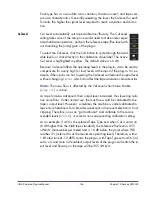
UAD Powered Plug-Ins Manual
- 170 -
Chapter 12: Ampex ATR-102
Manual Calibration Notes
• 0 dB on the output meter repr4 dBm (and –12 dBFS digital) when
Reproduce
is in its calibrated position, which is marked with the “red arrow
sticker.”
• For proper calibration, follow the entire calibration procedure in order.
• This example uses 3.5 dB overbias. The amount of gain reduction in step 12
determines the amount of overbias. In some cases we used more than
3.5 dB of overbias to achieve a flatter response.
• Generally speaking, higher
Cal Level
values will have higher
Distortion
Meter
values for a given reading on the
Meters
. If Bias is set very low, dis-
tortion may increase at lower Cal Levels.
• We recommend leaving the record SHELF EQ control in its default position.
• The Ampex ATR-102 hardware has an additional gain control via a set-
screw (like Repro HF/LF, Bias, etc) which is usually used for manual gain
calibrations. This control is not available in the plug-in because it would be
redundant – the Reproduce control performs the same function.
• We chose to calibrate our reference machine using MRL fringing-compen-
sated calibration tapes, without later adjusting the Repro LF EQ for unity
gain using external test tones. Therefore the calibrated values in the plug-in
reflect this alignment method. In-depth discussions about fringing compen-
sation and system alignment are beyond the scope of this manual; thorough
resources are available from the MRL website at:
http://www.mrltapes.com
• Tape Type 111 uses a calibration level of 0 dB. This value is not available
in the plug-in, but it can be emulated by setting the CAL level to +3 dB, then
reducing the input level (Record knob) by –3 dB and increasing the output
level (Reproduce knob) by +3 dB.
• The plug-in operates at an internal level of –12 dBFS. Therefore a digital sig-
nal with a level of –12 dB below full scale digital (0 dBFS) at the plug-in in-
put will represent 0 dB on the plug-in meters (if the plug-in is calibrated).
• The included artist presets demonstrate how manual calibration can be
used to obtain sonic variations (see
“Artist Presets” on page 150
).
Tip:
For easy recall in future sessions, save unique calibrations as a preset.
Содержание UAD
Страница 172: ...UAD Powered Plug Ins Manual 172 Chapter 12 Ampex ATR 102 Original Ampex ATR 102 Mastering Recorder Brochure ...
Страница 294: ...UAD Powered Plug Ins Manual 294 Chapter 27 Lexicon 224 Lexicon 224 Screenshot Figure 99 The Lexicon 224 plug in window ...
Страница 482: ...UAD Powered Plug Ins Manual 482 Chapter 47 Pultec and Pultec Pro Dip Response Figure 155 Pultec MEQ 5 Dip Response ...
Страница 497: ...UAD Powered Plug Ins Manual 497 Chapter 48 RealVerb Pro Figure 166 RealVerb Pro in Morphing mode ...
















































